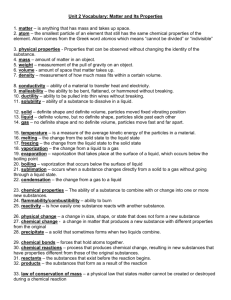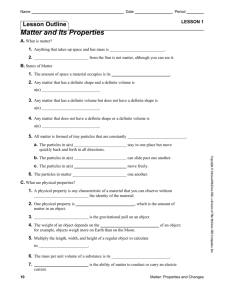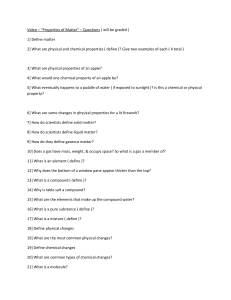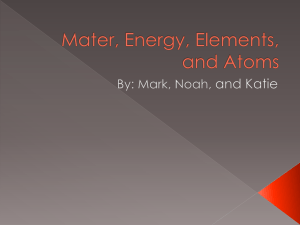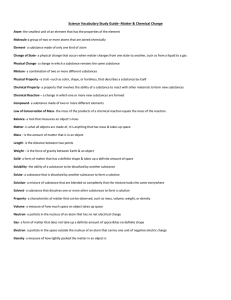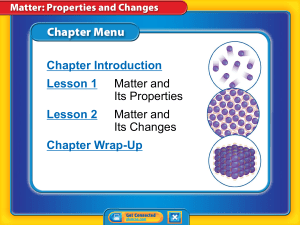File
advertisement
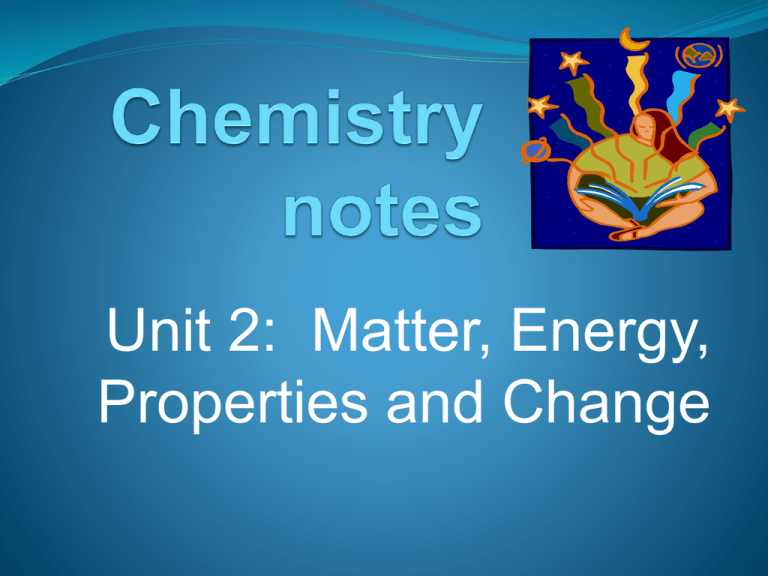
Unit 2: Matter, Energy, Properties and Change Pretest Give an example of a chemical change 2. Give an example of a homogeneous mixture. 3. What is the molar mass of carbon? 4. State the Law of Conservation of matter. 5. Can matter be changed into energy? If so, give the formula. 6. What is the molar mass of water (H2O)? 7. Calculate the percent composition of all the elements in water. 8. Give an example of each: element and a compound 9. How many chemical elements are there? 10. Describe a chemical reaction at the molecular level. 1. Some terms Matter – anything that has mass and takes up space Inertia – resistance to a change in motion Substance – cannot be broken down by physical means (filtration, recrystallization, distillation, etc), uniform and unchanging in composition, ex NaCl A pure substance is either a compound or an element. Kinetic Theory of Matter All matter has some kinetic energy Kinetic energy (speed) depends on temperature (variable) and mass (constant). The particles of matter are in constant motion If collisions occur, the collisions are elastic – they lose no energy States of Matter Solid – definite volume/shape; particles vibrate Liquid – definite volume, not shape; particles flow overtop of each other Gas – no definite shape/volume; particles spread out due to high KE Plasma – particles move so fast and violently that they break down into electrons and positive nuclei BEC (Bose Einstein Condensate) - … a 5th state? In 2003 a Bose-Einstein condensate was formed by chilling a gas to absolute zero (-273.15°C), where the motion of the particles slows and they combine in a single “super atom”. Very low energy. Solid shapes can be….. a)Amorphous (no definite arrangement) (graphite) b)Crystalline (is a definite arrangement) (diamond) Changes of Phase (State) Element The smallest particle of an element that retains its properties. A pure substance that cannot be separated into simpler substances by physical or chemical means Examples: any on PT (118) 92 naturally occurring Not the same in abundance 75% of universe is H 75% of earth’s crust is Si and O Compound 2 or more different elements combined chemically ~10 million known compounds Discovered at a rate of 100,000 per year Can be broken down into simpler substances by chemical means Properties of compounds are different from element components Example: NaCl, Mixtures – combination of 2 or more pure substances (retains each individual chemical properties) – can be separated (by physical means) Water - ? Pond water vs tap water vs distilled Salt - ? Salt water - ? Ocean water? Examples: Heterogenous mixture – does not blend smoothly throughout, individual substances remain distinct Examples: Homogeneous mixture – has a constant composition throughout and always has a single phase; also called a solution Examples: Strawberry milkshake Separating Mixtures Filtration – uses a porous barrier to separate solids from liquids, based on particle size Distillation – based on differences in the boiling points of substances involved Crystallization – results from the formation of pure solid particles of a substance from a solution containing dissolved substances Chromatography – separates on the basis of the tendency (adsorbption) of each to travel across the surface of another material Properties Physical property – can be observed or measured without changing the sample’s composition Examples: Extensive properties: depend on the amount of substance present Intensive properties: independent of the amount of substance present Chemical Property – the ability of a substance to combine with or change into one or more other substances Examples: Changes in Matter Physical change - changes which alter a substance without changing its composition Example: About nine states of matter exist…. like critical fluids Chemical Change – a process that involves 1 or more substances changing into new substances Example: Chemical change (reaction) vs physical change Boiling? Melting? Tearing? Carmelizing? Evidence of a Chemical Change Change in color Change in smell Change in temperature Endothermic – Exothermic – Gas released (bubbles) Precipitate forms (solid forms) ****Must be careful with these – one by itself is not definite proof Bellringer How many? Bose-Einstein condensate…. Draw the heating curve for water. Law of Conservation of Mass Mass is neither created nor destroyed during a chemical reaction – it only changes form. It is conserved. mreactants = mproducts A student separated water into hydrogen and oxygen. He collected 10.0 g of hydrogen and 79.4 g of oxygen. How much water was involved in the process? A 10.0 g sample of magnesium reacts with oxygen to form 16.6 g of magnesium oxide. How many grams of oxygen reacted? Law of Conservation of Energy Energy can neither be created NOR destroyed, only transformed. Energy is never “LOST”, just changed into a non-useful form. Law of Conservation of MatterEnergy The total amountof matter and energy must stay the same, but matter can be transformed into energy and vice-versa. c= velocity of light 2 E=mc 300, 000, 000 m/s or 186, 000 miles/sec Bookwork Pg 48 Restate the question Do #7, 8, 14, 24, 28-32 Bookwork Page 52 Restate the question # 23 Page 58 # 35-40, 42, 47, 54, 55, 56, 58, 60-63, 67, 69, 74 Page 61 # 1-10 Groupwork Pg 60 #74-77, 82 Pg 61 #11-14 Bellringer 1. 2. 3. 4. 5. Give 2 evidences that a chemical change is happening. Give 2 examples of a chemical change. Is the “volume” an example of an extensive or an intensive physical property? Is the “density” an example of an extensive or an intensive physical property? Chromatography is a method of separating the components in a __________ based on their solubility in a solvent. Calculations: Percent composition Determine % comp for each element in: A) water B) carbon dioxide C) ammonia (% hydrogen only) Calculations: Percent composition Determine % comp for the element stated in: A) % hydrogen in sulfuric acid B) % oxygen in ethanol C) % carbon in cholesterol (2,15-dimethyl-14-(1,5dimethylhexyl)tetracyclo[8.7.0.02,7.011,15]heptadec-7-en-5ol), C27H46O Liquids Intermolecular forces Intramolecular forces Evaporation Vaporization Boiling Boiling diagram Cooling process Vapor pressure VP indicates how volatile a liquid is Boiling point Sea level vs mountain top Pressure changes Special Properties of Water Expands when freezes, most solids constrict Hydrogen bonding Makes boiling and melting point much higher Ice is less dense than water due to H bonding – ice floats Cohesion: forces between identical molecules Adhesion: forces between different molecules Capillary rise (action) – rise of a liquid in a tube of small diameter due to unbalanced forces Why does water exhibit capillary action? Cohesion or Ad Surface tension – apparent elasticity of the surface of a liquid due to unbalanced forces Water has a high surface tension. Why? Co or Ad? Solids Melting diagram Crystal structures Crystalline vs amorphous Glass see page R20 Diamond vs graphite Allotropes Fullerenes See R21 Tutorials + videos https://www.youtube.com/watch?v=P_RQuRzp7SE Bozeman what students should know 11 min https://www.youtube.com/watch?v=VkeSI_B5Ljc what is a plasma Plasma Lab MD http://www.livescience.com/46506-states-ofmatter.html 5 states of matter https://www.youtube.com/watch?v=yBRdBrnIlTQ Supercritical fluid Nottingham Today Finish Chromatography Lab Discuss Lab Safety test retake results Binder checks Turn in Happy Fall Break!
